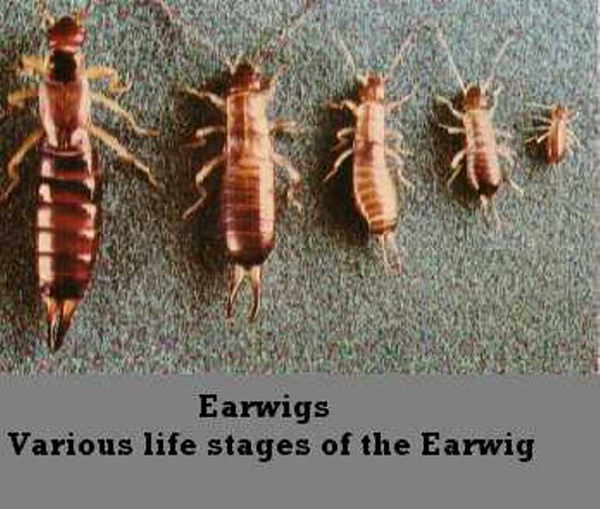|
Earwigs
Male earwig.
Earwigs are a fairly well-known insect, from folk lore if not from actual experience. The earwig is the insect reputed in superstition to purposefully crawl into the ears of sleeping persons for the purpose of burrowing into the brain to lay eggs. Of course, there is no truth to these tales, though earwigs, like moths, beetles, cockroaches, ants and flies may wander into our ear canals by accident.
Earwigs are fairly common, though not often abundant in Iowa. They are rarely noticed except after prolonged periods of a year or more with wet weather. Earwigs are relatively easy to identify by the prominent pincers or forceps on the end of the abdomen. On females the pincers are fairly straight, while male pincers are more curved and caliper-like. These pincers are used as both offensive and defensive weapons. Though they may try to pinch if captured and handled, they do not harm people. The common earwig is about 5/8 inch long and dark brown with a reddish head and pale yellow-brown legs.
Earwigs are outdoor insects usually found in damp areas, such as under mulch, dead leaves, logs, and piles of firewood, boards, stones and other debris or in rotted wood where they feed on moist, decaying plant material. Though earwigs occasionally attack living plants, including vegetables, flowers and ornamental plants, they are considered only minor pests of plants in Iowa.
Like boxelder bugs, crickets and lady beetles, the earwig is a household pest as an accidental invader. They enter houses either by accident or when seeking shelter, especially in the fall or during periods of prolonged dry weather. Earwigs inside the house do not cause any harm or destruction. They are an annoyance or nuisance because of their presence. If disturbed, earwigs may produce a noticeable foul odor.
Earwigs found inside the house can be swept or picked up and discarded. Indoor treatment with household residual insecticides such as for cockroaches could be used in cracks and crevices that serve as points of entry, and along baseboards, window sills and door thresholds. Such treatments may provide limited benefit as more earwigs may wander in from outdoors.
Several controls can be used outdoors. If possible reduce outdoor lighting that attracts earwigs around doors and windows . Reduce attractiveness of the landscape and breeding/hiding sites. Earwigs need and are very attracted to moisture. Eliminate damp, moist conditions near the house such as around faucets and air-conditioning units. Channel water from rain gutters and spouts away from the house foundation. Consider removing landscape mulch (wood chips, gravel, etc.) from against the house. Finally, prevent entry by using caulking compound, putty and weather stripping around doors, windows, pipes and other entry sites, especially at the ground level.
Some persons report being able to reduce earwig populations around the house by trapping. Place burlap bags, boards, newspapers or other cover material on mulch, shrubbery and similar habitats. Collect individuals that congregate under the cover and discard. As a last resort insecticides can be sprayed around the house to stop or limit earwigs from getting indoors. Treat a three to six foot band around the house adjacent to the foundation (perimeter treatment). Apply a home garden or turfgrass insecticide labeled for this purpose as needed and according to label directions. Applications in late afternoon are preferred. Use sufficient spray water (or post-treatment irrigation) to move the insecticide through mulch materials to the hiding places underneath. Insecticides available for this use by homeowners in Iowa include carbaryl (Sevin), cyfluthrin, permethrin and several more. |
